Author: Jerry Peterson
Since joining the Alpha Association in 2012 I have been thinking about returning to Vietnam. While I was there during 1967-68, I thought that it was a beautiful country but was being devastated by war. I wanted to see how it looked now during a peace period. Bill Braniff and I have talked about his visits there and I decided that it was time to go back.
 My wife and I arranged a trip through a tourist agency in Hanoi that specialized in return trips for American veterans. We worked together to create an itinerary that would allow my wife and I to travel for two days in the Dau Tieng/Tay Ninh/Cu Chi area. We wanted this trip to be concentrated on specific locations so we arranged to have our own guide and driver each day for this part of our trip.
My wife and I arranged a trip through a tourist agency in Hanoi that specialized in return trips for American veterans. We worked together to create an itinerary that would allow my wife and I to travel for two days in the Dau Tieng/Tay Ninh/Cu Chi area. We wanted this trip to be concentrated on specific locations so we arranged to have our own guide and driver each day for this part of our trip.
My primary interest was going back to Dau Tieng and finding areas that were meaningful to me. I had spent time over the last few years going over topographic maps from back then and planned ahead to visit those sites. I also used Google Earth to see the changes in the last fifty years. One obvious change was how Dau Tieng had grown from a small village to a city that now occupied most of what had been our base camp.
We left Saigon in the morning to head to Dau Tieng. The thing that really struck me during this drive was how large Saigon had become. The population is over 13 million now. The city seems to stretch almost all the way to Dau Tieng.
Our guide knows the Dau Tieng area very well and has brought other vets there for visits. When we were within two miles of Dau Tieng we were able to determine the spot where our command post was shot up by the mech along LTL 14 (Thunder Road). We stopped and I took a couple photos of the area. Back then this was a dirt road with a few huts along it. The road is now a four lane paved road with several villages.
From there we entered Dau Tieng. I had a map that I had printed from Google Earth along with a military map from 1970. Using these we drove to a point that I was sure the bunker line had been located. This was a street that now had houses along it. We stopped and spoke with the owner of one of the houses and he verified that the bunkers were located right along the front of where his house was now located. He also confirmed that the swimming pool was still there. From his house we drove to the swimming pool. Other than a new paint job is looked exactly the same.
It is in an area that has a war museum. There is a Huey, a tank, a jeep and several US bombs out front. From that point we drove down the road to the right to try to find the road that went from the company area to airstrip, but there was no road going through there.
We next proceeded to try to find the old Battalion HQ building. It is still there and looks exactly the same. It is now the headquarters of the Dau Tieng Rubber Corporation.
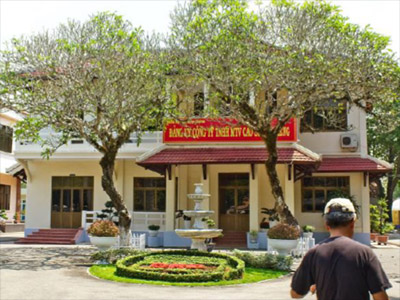
2/12th Battalion Headquarters Today
I next went back to find the old company area. We headed back towards the bunker line and turned where I had earlier determined must be the road where the company area was located. After going about a half of a block we saw a dirt road. Looking at the topographic map and the Google Earth map we were sure that this was the road running to the airstrip from A Company’s area.
There is now a house where the Alpha company area was back then. The owner came out as well as a neighbor and they confirmed that this road had once gone all the way to the airstrip. Looking down the road I could see where it met the road that followed the berm line around towards the airstrip. This was one of the most satisfying part of my trip.
We then drove to the airstrip. This is now overgrown on both sides of the airstrip. The tarmac is almost all gone now. The French colonial building (the Brigade Headquarters Building) that located at the junction of the two runways is no longer there.
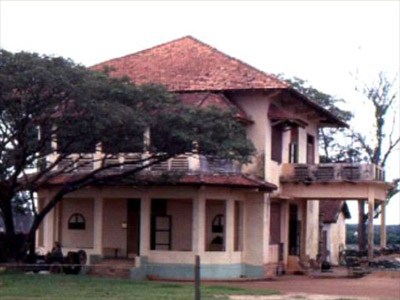
Brigade Headquarters, 1967-68
The road that went past the pool and Battalion HQ had, prior to the creation of the base, went from the bridge and straight east past the wire at the end of the airstrip. That road is now opened again and a busy highway. All along this road now are many shops just past where the Battalion HQ was. After seeing the airstrip, we decided to start heading towards Tay Ninh.
On the way out of Dau Tieng we stopped to take a photo of the old water tower before the bridge. We then crossed the bridge and took several photos from across the river. John Stone had spent his last few months in Vietnam guarding a bunker on the far side of the river. He shared with us this picture taken of the bridge and tower from his bunker:
A/2/12 troops at the rock crusher at the base of the Black Virgin Mountain, May, 1967
The trip to Tay Ninh brought back memories as we passed by rubber trees and rice paddies. As I watched Nui Ba Den come closer I remembered when we had been in 2 1/2-ton trucks headed to Tay Ninh on an operation. I thought about how we had guarded the ‘Rock Crusher’ at the base of it where they were cutting into the mountain for road building material.
Now around the mountain has become a recreational/attraction area. There are now two cable car lines that go 1/3 of the way up the mountain. From there you can get a view of the new reservoir that was created by damming the Saigon river just north of Dau Tieng. While we were there, the NVA and VC owned this mountain, from the bottom to almost the top. At the very top was a signal unit that we protected by special forces soldiers and other units. This base was overrun on May 13th, 68. Our company was sent up the next day to secure it.
Now, the mountain is visited by thousands of tourists every day. There is a famous ‘Reclining Buddha’ statue where the cable car line stops. Many Buddhists come here to pray in front of it. I will have more to tell you about Nui Ba Den at the reunion.
After staying overnight in Tay Ninh, we proceeded the next day to Cu Chi. The base there is now occupied by the Vietnamese army. We did drive around the perimeter of the base so that I could locate where our company was on the opening night of Tet ’68.
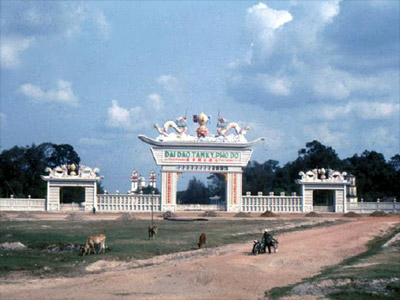
Temple Entrance 1967
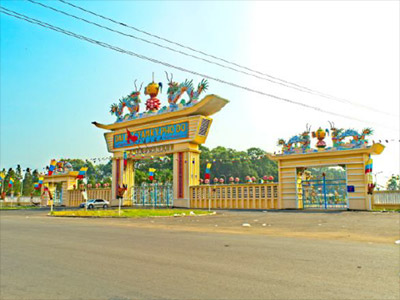
Temple Entrance 2018
We even snuck into the base for a short period which made me real nervous. I took this photo of the outside wall:
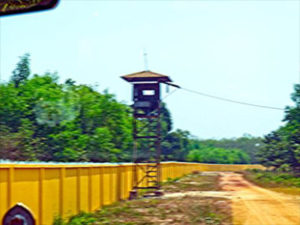
Base
We spent two days in Hue before traveling to Hanoi. We went to the Citadel while there. More about that at the reunion. We ended our trip in Hanoi. When we arrived there, we met our travel agent, I learned that her father had been an NVA soldier stationed inside of Nui Ba Den while we were there. (more on that later). While in Hanoi we visited Ho Chi Minh’s war headquarters. The furnishing was Spartan compared to western standards.
One of the most remembered captures in Hanoi is that of John McCain. On October 26, 1967, while flying on a bombing mission over Hanoi attacking a power plant, his plane was shot down. He ejected and he came down in Truc Bach Lake, nearly drowning. He was dragged out of the lake and beaten by angry residents. He was then sent to a prison known as the ‘Hanoi Hilton’ where he remained until March 14th, 1973.
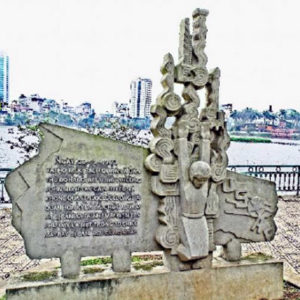
Statue of McCain Capture
The Vietnamese built this memorial later to commemorate his downing. The text says “On 26 October 1967 near Truc Bach Lake, the Vietnamese people in Hanoi caught Air Pirate John Sidney McCain. He was captain of a group who flew planes in the sky who attacked Hanoi. The number of plane was A4. The plane fell on the Yen Phu Power plant. This was one of ten planes that fell on the same day”
On the next page begins a collection of photos and a map comparing our base camp back in 1967-68 to what it looks like today. Thanks to Jerry Peterson, Doug Brablec, John Stone, Ed Smith, Richard Evans and Dan Hollister for their help with this story.
As you can see, the rubber trees are long gone and the jungle did what it does best; it returns. The Company street where we would line up is now a paved two-lane road. Humble homes line the streets today with people with long memories of what it was like in the old days.
To conclude this issue, here is that interview that Jerry asked his tour guide for before he left Vietnam. Her father was an old time NVA soldier who we chased around, but never could find. They were a very determined enemy and worthy of our respect. Here is what it was like for him and his fellow Vietcong soldiers in Tay Ninh Province while we were there.